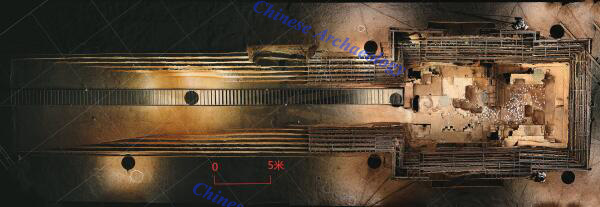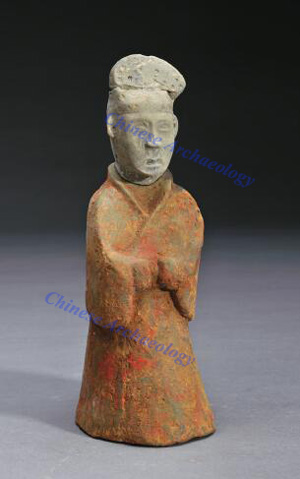High-rank tombs from Cao-Wei Period found in Xizhucun Cemetery, Henan
From:Chinese Archaeology NetWriter:Date:2017-01-20
Burials are located at about 650m south of Xizhucun Village, Koudian Town, Luoyang City and 20.4 km north of Changhe Gate of Luoyang ancient City from Han-Wei Periods. They are placed on the northern slow slope of Wan’an Mount and about 2.5km west of Huanqiu Site from Cao- Wei Peroid.
The aerial photo of Tomb M1
In July 2015, the tomb was found by villagers of Xizhucun Village. Considering the possibility of looting, with the permission of National Administration of Cultural Heritage, salvage excavation of the tomb was conducted. Meanwhile, large-scale archaeological survey and exploration of surrounding areas were also carried out in order to solve relative questions in terms of their mausoleum buildings and accompanied tomb. So far, whole explored area covered more than 1400,000 square meters. 2 large tombs (numbered as M1 and M2) were unearthed, both of which had no mounds and mausoleum remains. Now the excavation of M1 has been basically finished.
Tomb M1 has a long sloping burial passage with archy top,east-west oriented.The vaulted tomb chamber of tomb M1 was built in The vertical shaft pit and then covered with earth . It consisted of tomb passage, vaulted passage, front chamber and back chamber. In the southern, northern and western sides of the tomb, there were 39 post holes and 3 drainage ditches. The post holes in the southern and northern sides were regularly arrayed and almost north-south symmetry. They were about 1.2~2.5m away from the edges of the grave. Their intervals were about 1.6~2.7m. The earthen grave was nearly 52.1m long from east to west. And the upper opening of the tomb passage was 33.9m long from east to west and 9~9.4m wide with a 18 degree gradient. The grave of the chamber was roughly rectangular, about 18.2m long from east to west and 15m wide from south to north. The distance between opening and bottom of the tomb was about 10.8m. 7 horizontal earthen steps were remained on the south and north side walls of the passage with a 1.3~1.5m long interval between each other. There were 6 or 7 horizontal or sloping steps residue on the earthen grave of the tomb. Vaulted passage was 2.3m long and 1.6m wide. Inner wall of the front chamber was 4.8m long from south to north and 4.4m wide from east to west. Most of the arched top was already collapsed. There was remaining mural on bricked walls of the front chamber, which was in relatively poor state of preservation. The back chamber was nearly square in plane with a roughly 3.6m long side and an arched top.

Artifacts in situ

Pottery figurine found from the tomb
M2 was east-west oriented. The grave was 59.2m long. Tomb passage was on the east side of tomb chamber, 39.6m long and about 9.4~10.2m wide. The earthen grave of tomb chamber was 19.6m long from east to west and 13.8m wide from south to west. Besides, there were remains of post holes around the earthen grave.

Stone tablet with engraved inscription
Funeral goods from M1 were obviously similar to some of the burial goods from the tomb of Zhengshi reign’ 8th year and CaoXiu tomb in Luoyang, bearing East Han Dynasty to West Jin Dynasty transitional characteristics. The tomb has enormous scale, where unusual ritual artifacts were unearthed, including stone gui-tablets and bi-disks and so on. The inscription stone plaques uncovered from the tomb were only found in Cao Cao's Mausoleum before, which had relatively obvious indications of time and rank. According to documents, Ming Empire's Gaoping Mausoleum was located in Wan’an Mount area, while Mingyuan’s Queen was buried in the west of Gaoping Mausoleum. M2 found from the exploration had high and open position and so large scale that it could be empire’s mausoleum. Besides, M2, M1 and Huanqiu site of Cao Wei Periods could be roughly placed on the same east-west line. Therefore, M2 might be preliminarily predicted to be Cao Cao’s Gaoping Mausoleum and M1 was joint burial or accompanied tomb of Gaoping Mausoleum. However, identity of the tomb owner couldn’t be figured out now because M1 was heavily looted and no evidence directly related to identity of the tomb owner was found.
This excavation provides important materials for research on location and organizational system of cemetery from Cao Wei Periods. There are relatively less tombs from Cao Wei periods found throughout the country. Although the tomb was heavily looted, there were still a group of important artifacts being unearthed. Especially, there were plenty of inscription stone plaques being found from it, which could give precious historical materials for research on assemblage of burial gifts and funeral practice of high-ranked tombs from Cao Wei Periods. (Translator: Ma Huanhuan)

